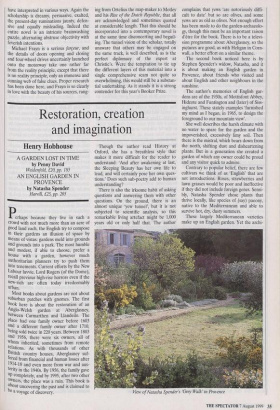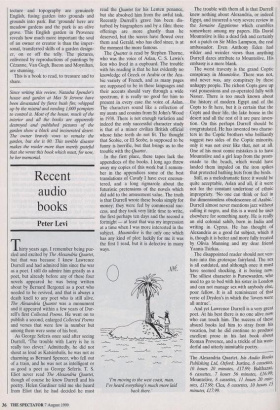Restoration, creation and imagination
Henry Hobhouse
Perhaps because they live in such a Crowd with not much more than an acre of good land each, the English try to compose in their gardens an illusion of space by means of vistas: gardens meld into grounds and grounds into a park. The most humble and modest, if able to choose, prefer a house with a garden, however much authoritarian planners try to push them into tenements. Current efforts by the New Labour luvvie, Lord Rogers (of the Dome), recall previous high-rise horrors even if the new-rich are often today irredeemably urban.
Most books about gardens are not about suburban patches with gnomes. The first book here is about the restoration of an Anglo-Welsh garden at Aberglasney, between Carmarthen and Llandeilo. The Place had one family owner before 1603 and a different family owner after 1710, being sold twice in 220 years. Between 1803 and 1956, there were six owners, all of Whom inherited, sometimes from remote relations. As with thousands of other British country houses, Aberglasney suf- fered from financial and human losses after 191448 and even more from war and aus- terity in the 1940s. By 1956, the family gave I-11) completely, and by 1995, after two other owners, the place was a ruin. This book is about uncovering the past and is claimed to be a voyage of discovery. Though the author read History at Oxford, she has a breathless style that makes it more difficult for the reader to understand: 'And after awakening at last, the Sleeping Beauty has her own life to lead, and will certainly pose her own ques- tions.' Does such sub-poetry add to human understanding?
There is also the irksome habit of asking questions and answering them with other questions. On the ground, there is an almost unique 'yew tunnel', but it is not subjected to scientific analysis, so this remarkable living artefact might be 1,000 years old or only half that. The author complains that yews 'are notoriously diffi- cult to date' but so are olives, and some yews are as old as olives. Not enough effort has been made to do the garden-archaeolo- gy, though this must be an important raison d'être for the book. There is to be a televi- sion programme about Aberglasney, so the pictures are good, as with Heligan in Corn- wall, a better effort on a similar theme.
The second book noticed here is by Stephen Spender's widow, Natasha, and it is about making an English garden in Provence, about friends who visited and about English and other neighbours in the sunshine.
The author's memories of English gar- dens are of the 1930s, of Mottisfont Abbey, Hidcote and Funtington and (later) of Siss- inghurst. These stately examples 'furnished my mind as I began, in 1965, to design the foreground to our mountain view'.
She well describes the harsh climate with no water to spare for the garden and the impoverished, excessively limy soil. Then there is the mistral, which bears down from the north, shifting dust and disheartening plants. But in a generation she created a garden of which any owner could be proud and any visitor quick to admire.
Contrary to popular belief, there are few cultivars we think of as 'English' that are not introductions. Roses, strawberries and lawn grasses would be poor and ineffective if they did not include foreign genes. Sensi- bly, Natasha Spender chose plants that thrive locally, like species of (say) paeony, native to the Mediterranean and able to survive hot, dry, dusty summers.
These largely Mediterranean varieties make up an English garden. Yet the archi- View of Natasha Spender's 'Grey Walk' in Provence tecture and topography are genuinely English, fusing garden into grounds and grounds into park. But 'grounds' here are meadow gardens and the park is an olive grove. This English garden in Provence reveals how much more important the soul of an owner or creator is than the imper- sonal, transferred skills of a garden design- er, on or off the telly. The pictures, enlivened by reproductions of paintings by Cezanne, Van Gogh, Bacon and Moynihan, are stunning.
This is a book to read, to treasure and to share.



























































 Previous page
Previous page